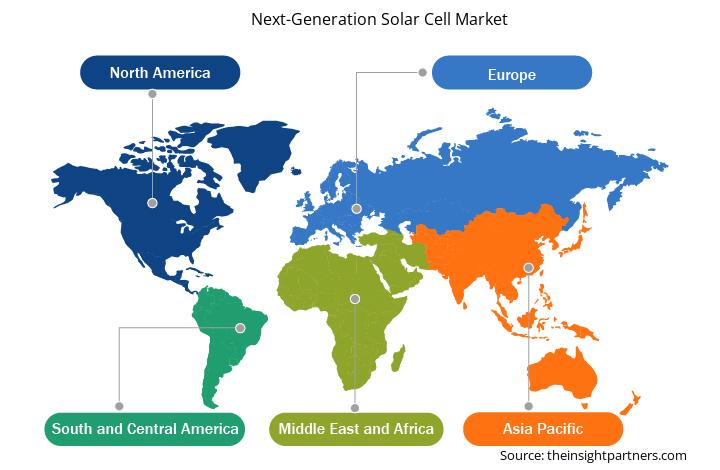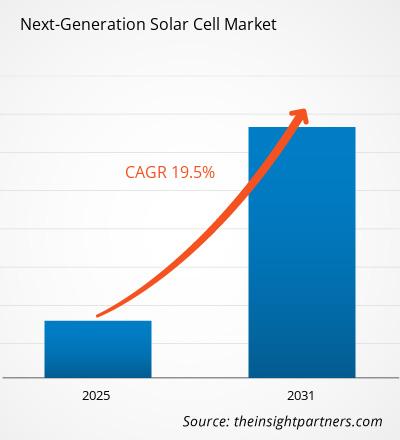글로벌 차세대 태양 전지 시장 규모는 2024년에 41억 3천만 달러로 평가되었으며, 2031년에는 129억 5천만 달러에 이를 것으로 예상됩니다. 차세대 태양 전지 시장은 2025년부터 2031년까지 연평균 성장률 15.73%를 기록할 것으로 추산됩니다. 지속 가능성과 친환경 제조는 시장의 주요 트렌드로 남을 것으로 보입니다.
차세대 태양 전지 시장 분석
차세대 태양 전지 시장은 청정 에너지, 태양광 기술 혁신, 그리고 변화하는 에너지 소비 패턴에 대한 전 세계적인 관심으로 인해 성장세를 보이고 있습니다. 이러한 시장의 주요 성장 동력 중 하나는 고효율 저비용 태양광 솔루션에 대한 수요 증가입니다. 페로브스카이트, 유기 태양광(OPV), 탠덤 태양 전지와 같은 차세대 기술은 향상된 에너지 변환율, 유연성, 그리고 경량 설계를 제공하여 건물 일체형 태양광부터 휴대용 전자 기기에 이르기까지 다양한 분야에 활용될 수 있습니다. 환경 문제 증가와 탄소 중립(Net-Zero) 정책은 정부와 기업의 첨단 재생 에너지 기술 투자를 촉진하고 있습니다. 유럽, 북미, 아시아 태평양 지역 등 다양한 지역의 인센티브, 보조금, 그리고 R&D 자금 지원은 신흥 태양광 기술의 상용화를 가속화하고 있습니다.
차세대 태양 전지 시장 개요
차세대 태양전지는 태양광 기술의 진화를 상징하며, 기존 실리콘 기반 태양광 패널에 비해 더 높은 효율, 더 낮은 제조 비용, 그리고 더 큰 다용성을 제공합니다. 이러한 첨단 태양전지는 페로브스카이트, 유기 태양광(OPV), 양자점, 다중 접합, 박막 태양전지 등의 기술을 포함합니다. 다양한 조명 조건에서 탁월한 성능을 제공하고, 가볍고 유연한 폼팩터를 제공하며, 다양한 표면 및 제품에 통합될 수 있는 잠재력을 통해 기존 시스템의 한계를 극복하도록 설계되었습니다. 또한, 생산 비용 절감과 확장성 향상의 가능성은 이러한 기술을 대규모 구축에 매력적으로 만듭니다. 기업들은 정부 정책 및 지속가능성 관련 규제를 바탕으로 차세대 태양광 솔루션의 상용화를 위해 R&D에 대한 투자를 늘리고 전략적 파트너십을 구축하고 있습니다. 세계 경제가 청정 에너지 및 탄소 중립 목표로 전환함에 따라, 차세대 태양전지는 기업의 혁신, 에너지 비용 절감, 그리고 장기적인 환경 보호 노력에 기여할 수 있는 전략적 자산으로 자리매김하고 있습니다.
이 보고서의 일부 또는 국가 수준 분석, Excel 데이터 팩을 포함하여 모든 보고서에 대한 사용자 정의를 무료로 받을 수 있으며, 신생 기업 및 대학을 위한 훌륭한 혜택과 할인도 이용할 수 있습니다.
차세대 태양 전지 시장: 전략적 통찰력

- 이 보고서에서 주요 시장 동향을 알아보세요.이 무료 샘플에는 시장 동향부터 추정치 및 예측까지 다양한 데이터 분석이 포함됩니다.
차세대 태양 전지 시장 동인 및 기회
가볍고 유연한 솔루션에 대한 수요 증가로 시장이 활성화되고 있습니다.
산업계가 재생 에너지를 비전통적이고 이동성이 뛰어나며 공간 제약이 있는 분야에 통합하려는 움직임에 따라 가볍고 유연한 태양광 기술에 대한 수요가 빠르게 증가하고 있습니다. 기존의 실리콘 기반 태양광 패널은 단단하고 무겁고 형태가 제한적이어서 항공우주, 자동차, 가전제품, 건설 등의 분야에서 활용도가 제한적입니다. 차세대 태양 전지, 특히 박막형 유기 태양광(OPV)과 페로브스카이트 기반 태양 전지는 상당한 이점을 제공합니다. 이러한 기술은 플라스틱, 유리, 금속 호일과 같은 가볍고 유연한 기판에 제조할 수 있어 곡면이나 움직이는 표면에 이상적입니다. 예를 들어, 항공우주 및 드론 기술에서는 무게가 중요한 요소입니다. 초경량 태양광 필름은 무게를 크게 늘리지 않고도 비행 시간을 늘리고 차량 내 시스템에 전력을 공급할 수 있습니다. 자동차 분야에서는 유연한 태양광 패널이 차량 지붕과 창문에 통합되어 배터리를 충전하고 차량 내 시스템에 전력을 공급함으로써 에너지 효율적인 전기 자동차(EV)에 대한 관심이 높아지고 있습니다. 마찬가지로, 가전제품 분야에서도 유연한 태양 전지 소재를 사용하면 에너지를 수확하는 웨어러블 기기, 센서, 모바일 기기를 만들 수 있습니다.
증가하는 글로벌 에너지 수요와 전기화
전기 자동차(EV), 스마트 홈, 산업 자동화, 그리고 도시 인프라 확장의 광범위한 도입에 힘입어 전 세계적인 전기화 추세가 빠르게 가속화되고 있습니다. 이러한 변화는 깨끗하고 안정적이며 분산된 전력원에 대한 전례 없는 수요를 창출하고 있습니다. 화석 연료와 중앙 집중식 전력망에 의존하는 기존 에너지 시스템은 현대 경제의 역동적이고 분산된 에너지 수요를 충족하기에 점점 더 부족해지고 있습니다. 차세대 태양광 기술은 이러한 과제를 해결할 핵심 솔루션으로 부상하고 있습니다. 기존 패널과 달리 페로브스카이트, 유기 태양광(OPV), 탠덤 셀과 같은 첨단 태양전지는 높은 효율, 유연한 통합, 그리고 확장성을 제공하여 다양한 사용 사례에 이상적입니다. 옥상, 차량, 인프라, 모바일 기기 등 다양한 장소에 설치하여 전력망 의존도와 송전 손실을 줄이는 분산형 에너지 모델을 지원합니다.
차세대 태양 전지 시장 보고서 세분화 분석
차세대 태양 전지 시장 분석 도출에 기여한 주요 세그먼트는 재료 유형, 설치 유형 및 최종 사용자입니다.
- 재료 유형을 기준으로 시장은 텔루르화 카드뮴(Cdte), 인도 갈륨 셀레나이드(CIGS), 페로브스카이트, 나노소재 및 기타로 구분됩니다.
- 설치 유형에 따라 시장은 온그리드(On-Grid)와 오프그리드(Off-Grid)로 나뉩니다.
- 최종 사용자를 기준으로 시장은 주거용, 상업용, 산업용으로 구분됩니다.
지역별 차세대 태양 전지 시장 점유율 분석
차세대 태양 전지 시장 보고서의 지리적 범위는 주로 북미, 유럽, 아시아 태평양, 중동 및 아프리카, 남미 및 중미의 5개 지역으로 나뉩니다.
아시아 태평양 지역은 2024년 시장을 장악했습니다. 아시아 태평양 지역은 강력한 정책 지원, 급속한 산업화, 그리고 증가하는 에너지 수요에 힘입어 차세대 태양 전지 시장의 핵심 성장 허브로 부상하고 있습니다. 중국, 인도, 일본, 한국, 호주 등 각국 정부는 화석 연료 의존도를 줄이고 적극적인 탈탄소화 목표를 달성하기 위해 재생에너지 인프라에 적극적으로 투자하고 있습니다. 특히 중국은 세계 태양광 제조 시장을 선도하고 있으며, 시장 지배력을 유지하기 위해 페로브스카이트 및 탠덤 셀과 같은 첨단 태양광 기술에 막대한 투자를 하고 있습니다. 인도 또한 태양광 발전 용량을 빠르게 확장하여 기후 및 전력망 수요에 맞는 고효율, 저비용 차세대 셀 개발 기회를 창출하고 있습니다. 한편, 일본과 한국은 유기 및 박막 태양광 기술 혁신을 활용하여 국내 에너지 수요를 충족하고 수출 주도형 성장을 견인하고 있습니다. 도시화, 전력화 증가, 그리고 농촌 및 오지 지역의 에너지 접근성 확대는 가볍고 유연하며 분산형 태양광 솔루션에 대한 수요를 견인하고 있습니다. 차세대 태양전지는 옥상 시스템, 모바일 기기, 건물일체형 태양광(BIPV) 등 이러한 응용 분야에 이상적입니다. 또한, 이 지역의 강력한 전자 및 자동차 산업은 첨단 태양광 기술과 자연스러운 시너지를 창출하며, 특히 전기자동차 및 가전제품에 통합하는 데 유리합니다. 이러한 요소들이 종합적으로 작용하여 아시아 태평양 지역은 차세대 태양전지 시장의 혁신과 도입을 주도하는 주요 동력으로 자리매김하고 있습니다.
차세대 태양 전지 시장 지역별 통찰력
The Insight Partners의 분석가들은 예측 기간 동안 차세대 태양 전지 시장에 영향을 미치는 지역별 동향과 요인들을 면밀히 분석했습니다. 이 섹션에서는 북미, 유럽, 아시아 태평양, 중동 및 아프리카, 그리고 중남미 지역의 차세대 태양 전지 시장 부문 및 지역별 현황도 살펴봅니다.

- 차세대 태양 전지 시장에 대한 지역별 데이터를 얻으세요
차세대 태양 전지 시장 보고서 범위
| 보고서 속성 | 세부 |
|---|---|
| 2024년 시장 규모 | 41억 3천만 달러 |
| 2031년까지 시장 규모 | 129억 5천만 달러 |
| 글로벌 CAGR(2025~2031년) | 15.73% |
| 역사적 데이터 | 2021-2023 |
| 예측 기간 | 2025-2031 |
| 다루는 세그먼트 | 재료 유형별
|
| 포함된 지역 및 국가 | 북아메리카
|
| 시장 선도 기업 및 주요 회사 프로필 |
|
차세대 태양 전지 시장 참여자 밀도: 비즈니스 역학에 미치는 영향 이해
차세대 태양 전지 시장은 소비자 선호도 변화, 기술 발전, 그리고 제품 이점에 대한 인식 제고 등의 요인으로 인한 최종 사용자 수요 증가에 힘입어 빠르게 성장하고 있습니다. 수요 증가에 따라 기업들은 제품 라인업을 확장하고, 소비자 니즈를 충족하기 위한 혁신을 추진하며, 새로운 트렌드를 적극 활용하고 있으며, 이는 시장 성장을 더욱 가속화하고 있습니다.
시장 참여자 밀도는 특정 시장이나 산업 내에서 활동하는 기업들의 분포를 나타냅니다. 이는 특정 시장 공간에 얼마나 많은 경쟁자(시장 참여자)가 존재하는지를 규모나 전체 시장 가치 대비로 나타냅니다.
차세대 태양 전지 시장에서 활동하는 주요 기업은 다음과 같습니다.
- 한화큐셀
- 옥스포드 PV
- 카네카 솔라 에너지
- 플리섬
- 미쓰비시 케미컬 그룹
- 하너지 박막 파워 그룹 헬리아텍
면책 조항 : 위에 나열된 회사는 특정 순서에 따라 순위가 매겨지지 않았습니다.

- 차세대 태양 전지 시장의 주요 기업 개요를 알아보세요
차세대 태양 전지 시장 뉴스 및 최근 동향
차세대 태양 전지 시장은 1차 및 2차 조사 이후 주요 기업 간행물, 협회 자료, 데이터베이스 등 정성적 및 정량적 데이터를 수집하여 평가합니다. 차세대 태양 전지 시장의 몇 가지 동향은 다음과 같습니다.
- 한화시스템은 자사 벤처인 플렉셀 스페이스(Flexell Space)가 에어버스 디펜스 앤 스페이스(Airbus Defence and Space GmbH)와 탠덤 태양전지를 활용한 차세대 우주 태양전지 모듈 개발 협력을 위한 의향서(LOI)를 체결했다고 밝혔습니다. 이번 협약을 통해 플렉셀 스페이스와 에어버스는 기존 모델보다 50% 이상 가벼우면서도 동등한 성능과 효율을 유지하는 우주 태양전지 모듈을 설계 및 개발할 계획입니다. (출처: 한화시스템, 보도자료, 2024년 8월)
- 연간 2GW의 생산 능력을 갖춘 인도 수랏 기반 선도적인 모듈 제조 브랜드인 나비타스 솔라(Navitas Solar)가 The Smarter E India – Intersolar India 2024에서 최신 차세대 N형 TOPCon 모듈을 출시했습니다. N형 TOPCon 기술은 뛰어난 에너지 수율과 낮은 온도 계수로 잘 알려져 있으며, 태양광 모듈의 전반적인 효율과 수명을 향상시킵니다. (출처: 나비타스 솔라, 보도자료, 2024년 2월)
차세대 태양 전지 시장 보고서 범위 및 제공 내용
"차세대 태양 전지 시장 규모 및 예측(2021~2031)" 보고서는 아래 영역을 포괄하여 시장에 대한 자세한 분석을 제공합니다.
- 범위에 포함된 모든 주요 시장 부문에 대한 글로벌, 지역 및 국가 수준의 차세대 태양 전지 시장 규모 및 예측
- 차세대 태양 전지 시장 동향 및 추진 요인, 제약, 주요 기회 등 시장 역학
- 자세한 PEST/포터의 5가지 힘 및 SWOT 분석
- 주요 시장 동향, 글로벌 및 지역 프레임워크, 주요 참여자, 규정 및 최근 시장 개발을 다루는 차세대 태양 전지 시장 분석
- 시장 집중도, 히트맵 분석, 주요 업체 및 차세대 태양 전지 시장의 최근 개발 사항을 다루는 산업 환경 및 경쟁 분석
- 자세한 회사 프로필
- 과거 분석(2년), 기준 연도, CAGR을 포함한 예측(7년)
- PEST 및 SWOT 분석
- 시장 규모 가치/거래량 - 글로벌, 지역, 국가
- 산업 및 경쟁 환경
- Excel 데이터세트
최근 보고서
관련 보고서
사용 후기
구매 이유
- 정보에 기반한 의사 결정
- 시장 역학 이해
- 경쟁 분석
- 고객 인사이트
- 시장 예측
- 위험 완화
- 전략 기획
- 투자 타당성 분석
- 신흥 시장 파악
- 마케팅 전략 강화
- 운영 효율성 향상
- 규제 동향에 발맞춰 대응




















 무료 샘플 받기 - 차세대 태양 전지 시장
무료 샘플 받기 - 차세대 태양 전지 시장